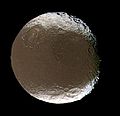Fil:Iapetus Spins and Tilts.jpg
Iapetus_Spins_and_Tilts.jpg (361 × 349 pikslar, filstorleik: 13 KB, MIME-type: image/jpeg)

Følgjande er henta frå filomtalen åt denne fila på Wikimedia Commons:
Filhistorikk
Klikk på dato/klokkeslett for å sjå fila slik ho var på det tidspunktet.
| Dato/klokkeslett | Miniatyrbilete | Oppløysing | Brukar | Kommentar | |
|---|---|---|---|---|---|
| gjeldande | 5. desember 2015 kl. 04:36 |  | 361 × 349 (13 KB) | PlanetUser | Cropped 42 % horizontally and 42 % vertically using CropTool with precise mode. |
| 10. oktober 2006 kl. 22:04 |  | 618 × 605 (18 KB) | Uwe W. | '''Original Caption Released with Image:''' Saturn's two-faced moon tilts and rotates for Cassini in this mesmerizing movie sequence of images acquired during the spacecraft's close encounter with Iapetus on Nov. 12, 2005. The encounter begins with Cas |
Filbruk
Den følgjande sida bruker denne fila:
Global filbruk
Desse andre wikiane nyttar fila:
- Bruk på af.wikipedia.org
- Bruk på an.wikipedia.org
- Bruk på de.wikipedia.org
- Bruk på en.wikipedia.org
- Bruk på en.wikiversity.org
- Bruk på fr.wikipedia.org
- Bruk på ja.wikipedia.org
- Bruk på ko.wikipedia.org
- Bruk på lt.wikipedia.org
- Bruk på lv.wikipedia.org
- Bruk på no.wikipedia.org
- Bruk på pt.wikipedia.org
- Bruk på ro.wikipedia.org
- Bruk på ru.wikipedia.org
- Bruk på sco.wikipedia.org
- Bruk på sk.wikipedia.org
- Bruk på tr.wikipedia.org
- Bruk på uk.wikipedia.org
- Bruk på vi.wikipedia.org


